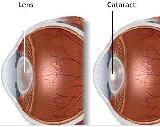Cataract

A cataract is a clouding of the lens in the eye which leads to a decrease in vision. Cataracts often develop slowly and can affect one or both eyes. Symptoms may include faded colors, blurry vision, halos around light, trouble with bright lights, and trouble seeing at night. This may result in trouble driving, reading, or recognizing faces. Poor vision caused by cataracts may also result in an increased risk of falling and depression. Cataracts are most commonly due to aging but may also occur due to trauma or radiation exposure, be present from birth, or occur following eye surgery for other problems. Risk factors include diabetes, smoking tobacco, prolonged exposure to sunlight, and alcohol. Either clumps of protein or yellow-brown pigment may be deposited in the lens reducing the transmission of light to the retina at the back of the eye.
Organism species: Mus musculus (Mouse)
- Disease model DSI577Mu01 Mouse Model for Cataract In Stock
- Disease model DSI577Mu02 Mouse Model for Cataract In Stock
- Disease model DSI577Mu03 Mouse Model for Cataract In Stock
- Disease model DSI577Mu04 Mouse Model for Cataract In Stock
- Disease model DSI577Mu05 Mouse Model for Cataract In Stock
- Customized Service n/a Tissue of Cataract (If Necessary) Tissue Customized Service Offer
- Customized Service n/a Serums of Cataract (If Necessary) Serums Customized Service Offer
Organism species: Rattus norvegicus (Rat)
- Disease model DSI577Ra01 Rat Model for Cataract In Stock
- Disease model DSI577Ra02 Rat Model for Cataract In Stock
- Disease model DSI577Ra03 Rat Model for Cataract In Stock
- Disease model DSI577Ra04 Rat Model for Cataract In Stock
- Disease model DSI577Ra05 Rat Model for Cataract In Stock
- Customized Service n/a Tissue of Cataract (If Necessary) Tissue Customized Service Offer
- Customized Service n/a Serums of Cataract (If Necessary) Serums Customized Service Offer
Organism species: Cavia (Guinea pig )
- Disease model DSI577Gu01 Cavia Model for Cataract In Stock
- Disease model DSI577Gu02 Cavia Model for Cataract In Stock
- Disease model DSI577Gu03 Cavia Model for Cataract In Stock
- Disease model DSI577Gu04 Cavia Model for Cataract In Stock
- Disease model DSI577Gu05 Cavia Model for Cataract In Stock
- Customized Service n/a Tissue of Cataract (If Necessary) Tissue Customized Service Offer
- Customized Service n/a Serums of Cataract (If Necessary) Serums Customized Service Offer
Organism species: Oryctolagus cuniculus (Rabbit)
- Disease model DSI577Rb01 Rabbit Model for Cataract In Stock
- Disease model DSI577Rb02 Rabbit Model for Cataract In Stock
- Disease model DSI577Rb03 Rabbit Model for Cataract In Stock
- Disease model DSI577Rb04 Rabbit Model for Cataract In Stock
- Disease model DSI577Rb05 Rabbit Model for Cataract In Stock
- Customized Service n/a Tissue of Cataract (If Necessary) Tissue Customized Service Offer
- Customized Service n/a Serums of Cataract (If Necessary) Serums Customized Service Offer
Organism species: Canis familiaris; Canine (Dog)
- Disease model DSI577Ca01 Canine Model for Cataract In Stock
- Disease model DSI577Ca02 Canine Model for Cataract In Stock
- Disease model DSI577Ca03 Canine Model for Cataract In Stock
- Disease model DSI577Ca04 Canine Model for Cataract In Stock
- Disease model DSI577Ca05 Canine Model for Cataract In Stock
- Customized Service n/a Tissue of Cataract (If Necessary) Tissue Customized Service Offer
- Customized Service n/a Serums of Cataract (If Necessary) Serums Customized Service Offer


